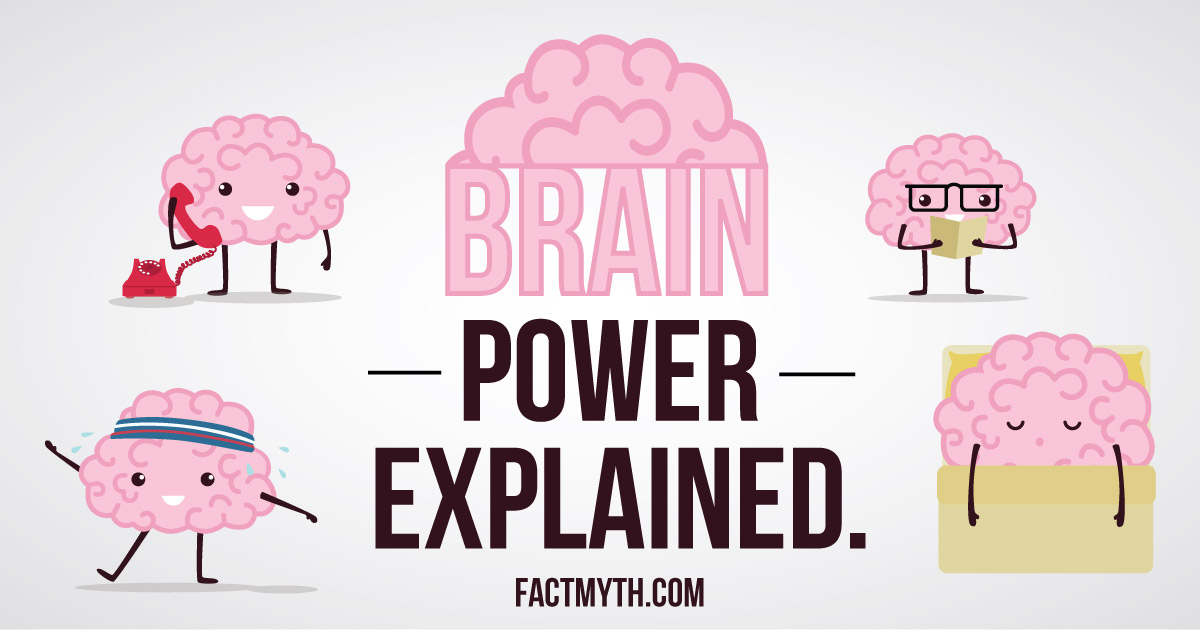Research shows that humans use nearly every part of their brain with most of the brain being active during any given day. However, there is much we don’t know about brain cells. What we do know shows plenty of potential and cells may contain “untapped potential” we don’t even know about yet. However, the idea that we only use 10% of our brain is a myth.
Humans Only Use a Small Part of Their Brain myth

How Much of Our Brain Do We Use?
Evidence suggests that humans use virtually every part of their brain on a daily basis. Some areas function more than others at any given time, but every part of the human brain has a function. People used to think the brain contained “silent areas”, and some speculated that it was full of untapped potential. Today we know the idea that “we only use 10% of our brain is a myth”, in a given day a person can use up to 100% of their brain.
Summary of Brain Usage in Humans:
- Every part of a healthy human brain has a function (i.e. there are no “silent areas”).
- A normal human uses nearly 100%, not 10% of their brain on a daily basis. This is true even during sleep.
- Some tasks require only a small part of the brain to be used. For instance a simple task may use 10% – 20% of the brain.
- A human with damage to even small part of their brain may lose important functions.
- The human brain accounts for only 2% of body weight but 20% of energy consumption. It has been speculated that, if humans didn’t need the whole brain, they would have probably evolved with smaller, more efficient brains.
- Brain cells not used have a tendency to degenerate. If humans didn’t use their brains, autopsy of normal brains would show degeneration of brain cells in unused areas.
- One reason some parts of the brain may appear inactive is that each part of the brain contains complex neurological pathways that may appear more or less active than other parts of the brain depending on the task being performed. New pathways are constantly being created and old one’s pruned away.
- Neuroscientists used to think the brain contained silent areas, but now they know these are just parts of the brain not in active use. During the night as we sleep there is even more brain activity.
Do We Really Only Use 10% of our Brain?
There is a common misconception that humans only use 10% of their brain and that the other 90% contains untapped potential. This is a myth. Throughout an average day, evidence suggests humans use most of, if not all of their brains, just as they use most, if not all their muscles, over the course of a day. At certain points in the day parts of the brain may be less active, and some tasks may only require some areas of the brain in order to perform them.[1]
This video discusses the 10% myth, the myth that we only use a small part of our brains.How Do Know We Use 100% of Our Brains?
We know we use 100% of our brain because brain imaging technologies can show areas of the brain being active. In a normal healthy human brain all areas show activity. “Silent” areas are only found on damaged brains.
Do Our Brains Function Even When We are Sleeping?
All areas of the brain function, even during sleep. In fact there is a lot of subconscious neurological activity that takes place during sleep.
Brain Growth
From birth a person will already have almost all their 86 billion neurons, but the connections between them haven’t formed well. As a child grows up their brain size increases about 5 fold. As the brain learns, it create complex neurological pathways that consume lots of energy but aren’t necessarily firing all the time (as they only appear active when needed.
Scientists didn’t always understand how the parts of the brain that contain these pathways worked. The misunderstanding of how neural networks function could have led to the misunderstanding about the percentage of our brains that are used. We now know today there are no “silent” areas in a normal brain, just parts of the brain that only activate when needed.
Synaptic Pruning
Another reason we can conclude that there is no “unused” part of the brain is synaptic pruning. Synaptic pruning is the process in which unused synaptic connections are eliminated to ensure the efficiency of the brain as it grows.[3]
Similar to synaptic pruning, unused parts of the brain weaken and deteriorate to avoid using up more energy than needed. When we do autopsies we don’t see any signs of deteriorating, hinting again that there is no “unused” part.
The brain already uses about 20% of the body’s total energy even though it only accounts for about 2% of total mass. We know the brain maintains efficiency by “pruning” pieces it doesn’t need.[1]
Is there Evidence Suggesting the Human Brain Has Untapped Potential?
There is no scientific evidence to suggest that there are “unused” portions of the average human brain that contain untapped potential, however the areas that are used hold lots of potential. There is still more to be known about the brain, and specifically brain cells. It is possible that brain cells may hold some key to untapped potential.[2]
It’s also worth noting that our current brain has evolved to this point, and further evolution is theoretically possible. Our brains are constantly evolving throughout our life actually rewiring as we learn and grow. So there is plenty of untapped potential, it’s just that it’s in parts of the brain we use all the time.
- “Do We Use Only 10% of Our Brains?“. Faculty.washington.edu. Retrieved Oct 20, 2015.
- “Ten Percent of the Brain Myth“. Wikipedia.org. Retrieved Oct 20, 2015.
- “Synaptic Pruning“. Wikipedia.org. Retrieved Oct 20, 2015.
